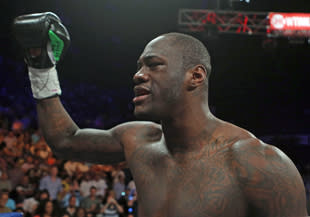Deontay Wilder may be America’s next great heavyweight, but he needs to fight top opposition first
Richard Schaefer has anointed Deontay Wilder as the second coming of Mike Tyson and is trying to push him into a shot at the heavyweight championship following a first-round knockout Saturday in Bayamon, Puerto Rico.
The victory raised Wilder to 31-0 and the knockout was his 31st. He has 18 first-round knockouts.
Wilder, a bronze medalist in the 2008 Olympics in Beijing, is at about the same point in his career that other top-level heavyweight champions of recent vintage have been when they first won the title.
Tyson was 20 years old, the youngest to ever win the belt, and was 27-0 when he faced Trevor Berbick for the belt in 1986. Lennox Lewis won his first world title at 27, when he was 22-0. Evander Holyfield was 24 when he first captured the heavyweight title, when he was 24-0. Riddick Bowe was 25 and had a 31-0 mark when he beat Holyfield for the belt in one of the great heavyweight matches of the last 50 years.
Vitali Klitschko was 24-0 and was 27 years old when he captured his first heavyweight title. And his younger brother, Wladimir, was 24 and had a 34-1 mark when he first became champion.
But Wilder is extremely difficult to evaluate as a prospect because of his extraordinarily low level of competition. It's not as if the division is teeming with elite prospects, but Scott was by far the most accomplished fighter that Wilder has faced and still isn't ranked in the Top 15 by any of the major organizations.
My gut instinct says to judge Wilder by the way his handlers match him. And because it appears they've matched him extraordinarily gingerly, it says a lot about what they think of him. He's 28 and seemingly at or past the time in his career when he should be battling the best the division has to offer.
Instead, he was paired with Scott, a wily veteran who isn't known as much of a puncher.
Much has been made online of the way that the fight ended, and that Scott seemed to deflect some (or all) of the power on the right hand. But watch the video below in slow motion and at the 22-second mark, it's clear that Wilder's right gets fully through Scott's gloves. Wilder also turns into the punch, putting the maximum power on it.
Those who are suggesting that Scott took a dive haven't been hit by a big shot. It was a clean right hand from a massive guy which landed squarely on the chin. Unless some evidence surfaces to show that something untoward occurred, I'll believe that it was a legitimate knockout.
But is that enough to anoint Wilder as America's next great heavyweight? No.
He is 6 feet 7 inches and weighed 227 pounds Saturday. He has a great frame and has scored knockouts with both hands. He seems to move well in the ring and has a clear sense of how to put his punches together.
No question, he's a gifted fighter. But one can't tell how good a fighter is until he beats an opponent who is at or near the same level as he is. It was impressive to blow away Scott in the manner he did, because Scott is a veteran who was 70-3 as an amateur and now 36-2-1 as a pro and had never been handled like that before.
But Scott didn't have the pop to threaten Wilder and nor had he done much to inspire confidence in terms of his past performance. Most of Scott's victims were of the questionable variety, as well.
Wilder may be good; he may even turn out to be great. But the only way to tell is to take the reins off and let him fight the best competition.
It's long overdue.

 Yahoo Sports
Yahoo Sports 


